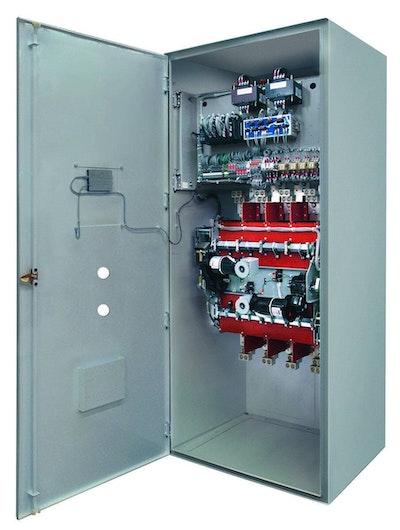Interested in Energy?
Get Energy articles, news and videos right in your inbox! Sign up now.
Energy + Get AlertsHurricanes, floods and other natural disasters in the news highlight the importance of reliable emergency power for water and wastewater treatment facilities.
Besides providing backup electric power, engine-generator sets and accompanying switchgear can deliver cost savings through peak shaving and utility-sponsored demand response programs.
Russelectric, a Siemens business, offers sophisticated emergency power systems. The company’s paralleling switchgear offers redundant programmable logic controller controls and manual backup capability.
The complete systems are custom designed and UL listed. The design allows manual start and synchronization of the generator sets if automatic controls malfunction. The systems can also control microgrid systems using combinations of conventional and renewable power sources.
Designed for safety and operating simplicity, the systems are SCADA-compatible. A 23-inch LCD touchscreen display enables operators to view system one-line diagrams, alarms and setpoints. Load demand sensing determines the number of generators online. John Stark, product line manager and marketing communications specialist with Russelectric, talked about the technology in an interview with Treatment Plant Operator.
TPO: What is your company’s history in the emergency power sector?
Stark: The impetus was the 1965 blackout in the Northeast that left 13 million people without power. Before that, people used portable generators for emergencies. Our founder, Ray Russell, was in that business. After the blackout the government began to mandate on-site emergency backup power systems. And Ray switched his focus to manufacturing power control systems for critical facilities.
TPO: How has your emergency power system evolved since then?
Stark: We manufactured our first emergency system in 1973, and it has been an evolving product ever since then. The structures and mechanical components, and the circuit breakers and automatic transfer switch technology, have remained largely unchanged. It’s in the electronics where we keep generating design improvements and enhancements.
TPO: What would you cite as a unique feature of your systems?
Stark: We build a manual hard-wired backup into our systems, in case computerized control fails. Our systems have dual computers. In the unlikely event that both of them go down, the users only have to flip one switch to activate full manual control. Then they assume control through the traditional means of turning knobs, flipping switches and reading meters.
TPO: What is your basic approach to working with customers on installations?
Stark: Every power control system we build is custom-engineered. We work with a consulting/specifying engineer to tailor the system to perform the way it has to for the specific installation. We have a very high ratio of in-house project engineers to manufacturing people. We fabricate and paint systems in-house. Our structures are assembled using numerous welds instead of bolts. We build extremely durable switchgear.
TPO: How do operators monitor and operate the system?
Stark: The operator interface panel is a touchscreen control on the cabinet. It can be connected to multiple monitors and control rooms throughout a facility. The operator interface allows users to exercise complete control from the cabinet door. In addition, as an option, we can provide a simulator where users can train operators to use the system. It’s not a generic simulator. We can completely simulate the custom-designed power control system that we built for the customer.
TPO: How does your system respond to a utility outage?
Stark: On receiving the signal of loss of the normal power source from automatic transfer equipment, the system automatically sends commands to start on the engine-generators. The first generator set to reach the preset voltage and frequency is connected to the bus by automatically closing its circuit breaker. The system then permits the first-priority loads to transfer to that genset while delaying the transfer of lower-priority loads until more generator capacity has been connected. In most cases this is hardly a delay at all.
TPO: How is system control maintained through the duration of the outage?
Stark: The system manages automatic paralleling of the remaining generator sets to the emergency bus, as they are available, through their individual synchronizers and circuit breakers. The system signals lower-priority loads to transfer to the emergency power system as generator sets are added to the bus. If a generator set fails during emergency operation, the system manages the shedding of low-priority loads, thereby ensuring that the high-priority loads receive continuous power. When normal power is restored, the system alerts the generator sets to disconnect and shut down after an unloaded cooldown period.
TPO: Beyond emergency power, what kinds of applications can your systems control?
Stark: We can manage utility paralleling, demand response and peak shaving as well as prime power for remote sites. And now with climate change and the challenges we face with weather events, we have added the ability to incorporate solar panels, wind turbines and other types of power generation in our advanced microgrid control systems.
TPO: How does the technology function in microgrid environments?
Stark: We’re plugged into all the different power assets, and we monitor and control them. An analogy is that these power sources are like musical instruments. We harmonize them so that they make good music. Our systems are essentially the conductors of the orchestra. They make sure the power sources play nicely and dynamically together.
TPO: What are some specific functions the technology can perform in a microgrid?
Stark: The switchgear physically and electrically connects and controls facility loads and generation. Meanwhile a state-of-the-art-of software controller can configure microgrid performance and the sequence of operations; optimize the system for resilience, cost and carbon emission mitigation, secure cyber communications, forecast loads and renewable generation, manage energy market transactions and more.
TPO: What other attributes does your company offer?
Stark: We have been in the power control system business for over 60 years. We have an excellent capability to support our customers. We have a reputation for reliability. Our equipment is made in the USA.







